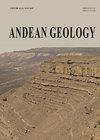Aportes a la metalogénesis del basamento proterozoico superior-cámbrico de las Sierras Pampeanas Orientales: mineralogía, termometría e isótopos de azufre del skarn Malagueño (Cu- Fe±Zn), Sierra Chica, Córdoba, Argentina
IF 1.2
4区 地球科学
Q3 GEOLOGY
引用次数: 0
Abstract
On-going mining operations in a marble quarry (Cantera Centro) from Malagueno, Sierra Chica de Cordoba, Argentina, have unearthed veins, veinlets and lenses of sulfides (pyrrhotite>pyrite≅ chalcopyrite>>sphalerite). These veins and lenses are up to 0.3 m thick and 2-3 m long, although intermittently can extend about a hundred meters. They are associated with skarns. The metasedimentary host sequence, largely composed of gneisses, amphibolites and marbles, was intruded by amphibolic metagabbro and metadiorite dykes, metatonalite plutons and alkali-feldspar metagranites; the whole complex was metamorphosed into medium to high amphibolite facies and strongly deformed as a result of the a regional event M2-D2/D3 that affected the Neoproterozoic-Cambrian basement during the Pampean orogeny. Except for gneisses, all the other metamorphic lithologies register evidence of differential alteration into skarn, although the process was preferentially developed on marbles, amphibolites and metagranite, and to a lesser exten on mafic and mesosilicic dykes. The metasomatic rocks are characterized by a garnet>>pyroxene skarn (Grs27-48Adr22-34Alm15-27Sps9-21), formed after the replacement of the metagranite; a pyroxene-rich skarn (Hd42-63Di32-50Jo3-5) developed after para-amphibolite, and a garnet (Adr54-71Grs22-40Alm4-7Sps1-2) (±wollastonite) skarn that replaced a calcic marble. The dykes show poor metasomatic replacement and lack sulfides of metasomatichydrothermal origin. Retrograde mineral associations include hastingsite, ferroactinolite, epidote, clinozoisite, sericite, plagioclase (An18), chamosite and calcite. The sulfide mineralization is paragenetically associated with late-stage, infilling skarn-hydrothermal minerals that were sequentially deposited as: calcite→clinochlore→quartz→pyrite→pyrrhotite→chalcopyrite+sphalerite; these phases occur as veins and veinlets within the garnetpyroxene skarn, and as massive pyrrhotite lenses in the piroxene-rich skarn. Microthermometric data from fluid inclusions in sulfide related calcite, together with the geothermometric data from the Fe/Mg ratios in clinochlore and the phase equilibria data from intergrown high and low T oC pyrrhotite phases, all constrain the infilling gangue phases and sulfide crystallization temperature within the ~360 °C to 250 °C range; the gradual termal decrease is in agreement with the temporal depositional sequence of the infilling phases. Fluid inclusion petrographic data and salinity estimations suggest that sulfide precipitation was triggered by boiling, from a fluid of moderate to high salinity (~14.5 to 33.5 wt% eq. NaCl). Evidence that the fluid evolved under dominantly reducing conditions are the high Fe+2/(Fe+2+Fe+3) ratios and molar proportions of subcalcic garnet (Alm+Sps) in garnet-pyroxene skarn, the presence of fluid inclusion sulfide daughter crystals in calcite, the high H2S/SO42- ratios in the sulfide-bearing fluid and the presence of pyrrhotite among the sulfide phases. Disseminated primary chalcopyrite and pyrite in metagabbro-diorite dykes (Cu ~300 ppm) and the high contents of Cu in amphibolite (~900 ppm) suggest that these protolithic lithologies were the probable sources of metals (Cu>>Zn±Ag). Values of δ34SΣfluid between ~-4 to +1.4‰ obtained from the fractionations factors of pyrite, pyrrhotite and chalcopyrite within the thermal range 350-150 oC, indicate a magmatic source for sulfur, likely provided by leaching or desulfidation of primary sulfides of the metagabbro-diorite dykes. Metals and sulfur supplied by these dykes and amphibolite would have been redistributed in the skarn after the circulation of the metasomatic-hydrothermal fluids. Skarn bodies would have formed by infiltration of deep metasomatic fluids and fluid-rock interaction which affected lithologies of the Upper Proterozoic-Cambrian metamorphic basement. Fluids could have derived from hidden Cambrian intrusives, or from the surrounding regional migmatization, channeled along lithological contacts and faults/fractures. Field setting, textural and mineralogical evidence of sulfide mineralization in the skarn assemblage of Cantera Centro, suggest a Cambrian age associated to the post-deformational stage of the Pampean Orogeny.对东潘帕斯山脉上元古代-寒武纪基底成矿的贡献:马拉加夕卡岩(Cu-Fe±Zn)、塞拉·奇拉、科尔多瓦、阿根廷的矿物学、温度计和硫同位素
在阿根廷科尔多瓦山脉马拉盖诺的大理石采石场(Cantera Centro)进行的采矿作业中,发现了硫化物的矿脉、细脉和透镜体(磁黄铁矿>黄铁矿>黄铜矿>>闪锌矿)。这些矿脉和透镜体厚达0.3米,长2-3米,尽管间歇性地可以延伸约100米。它们与矽卡岩有关。变质沉积宿主序列主要由片麻岩、角闪岩和大理岩组成,被角闪变辉长岩和变闪长岩脉、变英云闪长岩深成岩体和碱性长石变花岗岩侵入;整个杂岩变质为中高角闪岩相,并由于潘潘造山运动期间影响新元古代-寒武系基底的区域事件M2-D2/D3而强烈变形。除片麻岩外,所有其他变质岩都记录了矽卡岩差异蚀变的证据,尽管该过程优先在大理岩、角闪岩和变质花岗岩上发展,在镁铁质和中硅化岩脉上发展程度较小。交代岩的特征是变质花岗岩置换后形成的石榴石>>辉石矽卡岩(Grs27-48Dr22-34Alm15-27Ps9-21);富含辉石的矽卡岩(Hd42-63Di32-50Jo3-5)是在准角闪岩之后形成的,石榴石(Adr54-71Grs22-40Alm4-7Sps1-2)(±硅灰石)矽卡岩取代了钙质大理岩。岩脉交代交代交代作用差,缺乏交代交代热成因的硫化物。逆变质矿物组合包括辉长岩、铁阳起石、绿帘石、斜帘石、绢云母、斜长石(An18)、洋甘菊和方解石。硫化物矿化与晚期共生,充填矽卡岩热液矿物,这些矿物依次沉积为:方解石→斜绿泥石→石英→黄铁矿→磁黄铁矿→黄铜矿+闪锌矿;这些相在石榴石-辉石矽卡岩中以脉和细脉的形式出现,在富含吡洛西烯的矽卡岩内以块状磁黄铁矿透镜体的形式出现。硫化物相关方解石中流体包裹体的微温测量数据,以及斜绿石中Fe/Mg比率的地热测量数据和共生高温和低温磁黄铁矿相的相平衡数据,都将填充脉石相和硫化物结晶温度限制在~360°C至250°C范围内;充填期的逐渐递减与充填期的时间沉积序列相一致。流体包裹体岩相数据和盐度估计表明,硫化物沉淀是由中等至高盐度(约14.5至33.5wt%当量NaCl)的流体沸腾引发的。流体在主要还原条件下演化的证据是石榴石-辉石-矽卡岩中亚钙石榴石(Alm+Sps)的高Fe+2/(Fe+2+Fe+3)比和摩尔比,方解石中存在流体包裹体硫化物子晶体,含硫化物流体中的高H2S/SO42-比,以及硫化物相中存在磁黄铁矿。变质辉长岩闪长岩脉中散布的原生黄铜矿和黄铁矿(Cu~300ppm)以及角闪岩中的高铜含量(~900ppm)表明,这些原石器时代的岩性可能是金属(Cu>>Zn±Ag)的来源。在350-150℃的温度范围内,黄铁矿、磁黄铁矿和黄铜矿的分馏因子得出的δ34S∑流体值在~4至+1.4‰之间,表明硫的岩浆来源,可能是由变质辉长岩-闪长岩脉的原生硫化物浸出或脱硫提供的。交代热液循环后,这些岩脉和角闪岩提供的金属和硫会在矽卡岩中重新分布。矽卡岩体可能是由深交代流体的渗透和流体-岩石的相互作用形成的,这影响了上元古代-寒武纪变质基底的岩性。流体可能来自隐藏的寒武纪侵入岩,或来自周围的区域混合岩化,沿着岩性接触和断层/裂缝流动。Cantera Centro矽卡岩组合中硫化物矿化的野外环境、结构和矿物学证据表明,寒武纪与潘潘造山运动的后变形阶段有关。
本文章由计算机程序翻译,如有差异,请以英文原文为准。
求助全文
约1分钟内获得全文
求助全文
来源期刊

Andean Geology
地学-地质学
CiteScore
3.90
自引率
0.00%
发文量
17
审稿时长
>12 weeks
期刊介绍:
This journal publishes original and review articles on geology and related sciences, in Spanish or English, in three issues a year (January, May and September). Articles or notes on major topics of broad interest in Earth Sciences dealing with the geology of South and Central America and Antarctica, and particularly of the Andes, are welcomed.
The journal is interested in publishing thematic sets of papers and accepts articles dealing with systematic Paleontology only if their main focus is the chronostratigraphical, paleoecological and/or paleogeographical importance of the taxa described therein.
 求助内容:
求助内容: 应助结果提醒方式:
应助结果提醒方式:


